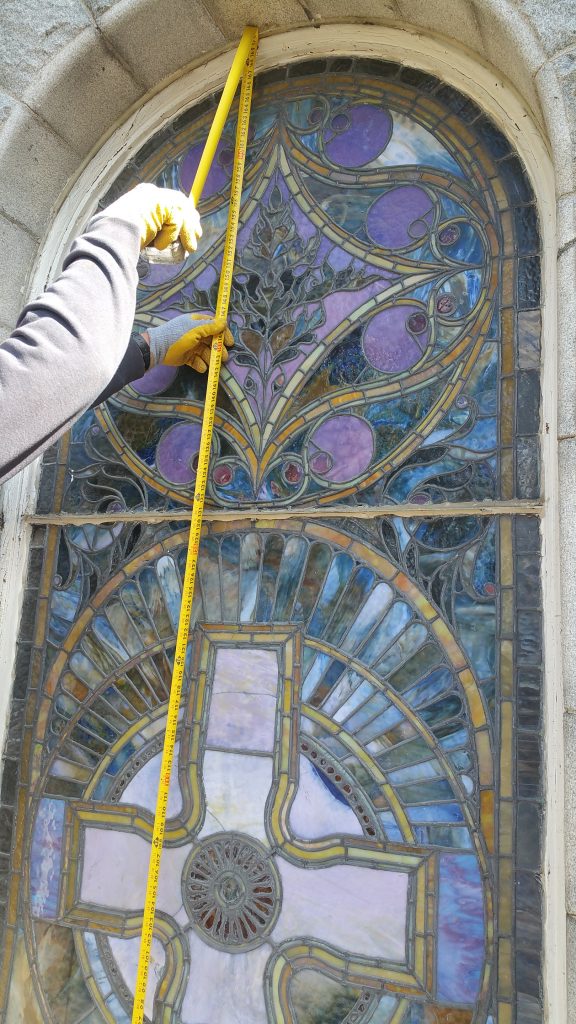Here at Glass Source Studios, we create, restore and preserve Stained and Leaded glass windows for a variety of buildings throughout the tri-state area. Ever wonder what this process entails? Below is a (somewhat) brief explanation of our restoration process that we use here at the studio. If you feel that your stained or leaded glass windows are in need of restoration, call us today for a free consultation!
Full restoration of leaded windows involves removing each of the panels. This can be done one window at a time or we can remove several. We would bring the window panels to our studio here in Shelton CT. Each window would be fully documented; cataloged, photographed and numbered. We will create rubbings from which the rebuilding pattern would be made and assign a number to each individual piece of glass that will correspond to the rubbing pattern. At this point each piece of glass is carefully removed one by one from the old lead channel. If there are any cracked pieces of glass we will edge glue these pieces together in order to maintain the artistic and historical integrity of the windows. When there are pieces within windows that are either broken with missing pieces or have multiple cracks that cannot be glued. We would replicate any of the pieces that cannot be saved. This process is done by having either an exact or closest available matching glass cut and refit or will also make glass as needed for this process.
Painted windows only: The replicated pieces will also be painted using traditional Reusche paint which is fired on in a kiln. Each piece of glass throughout the window is hand painted in this manner. Once the paint is fire it become permanent. Any of the original paint throughout the window that is unstable will be stabilized and touched up using a cold painting method. This is done using archival oil paint and sealed which under good conditions can last well over 100 years.
After each panel is fully dismantled we will clean each piece of glass using a non-caustic / non-acidic cleaner that will not adversely affect the original pieces. This process helps to remove any old dirt and soot from over the years as well as removing old cement that may be stuck to the glass this is the most tedious part of the project, however one of the most important. Once all of the glass is cleaned we will insert each piece into a new lead channel that has a matching profile and size to that of the original. We have the lead caming created to the specifications of the original lead used in the windows. There are many lead channels readily available however these do not match the original lead and would not keep in line with proper restoration of windows such as these. As we complete each panel each one will be cemented using black glazing cement that is pushed into the lead channels. This gives the window structural stability and seals them. Each panel will lay flat for two to five days depending on the humidity before the new copper ties are soldered on. The copper ties are what hold the window panels securely to the reinforcing bars. The reinforcing bars will give added structural support to each panel to aid in minimizing future bowing. The original reinforcing bars will be reused if possible after they are sand blasted to remove any rust that may be present and repainted. Once each panel is fully restored it will be ready to be installed into its original opening.
All of the restored panels should be addressed periodically in the future. This would entail examining each window 20 to 30 years from now and assessing the condition of the cement. The cement is the structural glue that holds all of the glass and lead tight. Due to expansion and contraction as well as heat can cause the cement between the lead to crack and dry out. A simple re-cementing of panels that need it over the years can help to make the restored windows last much longer. This theory is relatively new in the United States; however, it has been practiced in Europe for the past few hundred years. There are windows throughout Europe that are nearing 300 years old and are just now, needing to be restored .They have been addressed over the years and any signs of deteriorating cement or bowing were fixed before they became an issue. Here in the U.S. we are now adopting this practice and in turn lessening the future maintenance cost of leaded glass windows and prolonging the life expectancy of the lead matrix.
Preserving your stained glass windows can be divided into three groups: Routine Maintenance, Repairs and Restoration:
Maintenance includes cleaning. Special care needs to be taken when cleaning stained glass windows, especially painted stained glass. Ammonia based cleaners should NOT be used on stained glass as over time ammonia produces a negative reaction to lead came. Acid based cleaners, even including vinegar, should never be used on painted stained glass as these can damage the painted glass. Painted stained glass should always be tested for stability prior to cleaning. When in doubt, do not clean the painted areas of your stained glass windows. The damage to the painted areas of a stained glass window is non-reversible. A professional biodegradable pH neutral cleaner such as Triton X or Orvis horse shampoo which is readily available from your local tack shop works well and can be safely used to clean your stained glass windows once any glass painting has been tested for stability. The stained glass should be cleaned with a soft cotton cloth.
The perimeter putty that holds many stained glass windows into the sash and steel T-bar system needs to be replaced when it becomes loose. Stained glass window frames need to be painted, the perimeter re-caulked, and rotted section of wood or stone need to be replaced or stabilized with proper epoxy consolidation methods. The steel reinforcing systems in stained glass windows separate from the stained glass windows over time due to the expansion and contraction cycles. Periodically the steel reinforcing bars need to be examined and reattached where they have broken away from the stained glass windows. The steel reinforcing bars do not hold the window up, rather they provide stability and support.
That is the job of the steel T-bar and mullions. The steel reinforcing bars hold the stained glass in a flat vertical plane. Since the lead came is very soft, as long as the stained glass remains in a flat vertical plane it retains its stability.
Damaged or broken areas of stained glass windows need the appropriate repairs for the damage incurred. Broken panes need to be glued back together or replaced. Damaged areas may need to be replaced. Fire damaged stained glass windows need professional evaluation and a complex set of specifications for restoration, or may need to be replaced in part or in full.
Repair and maintenance of stained glass windows can include what some call stop gap measures which extend the life of your stained glass windows until the time they will need a full restoration. These procedures can be categorized as repairs and maintenance, or as restoration, and probably fit somewhere in between.
These measures include re cementing the stained glass window, replacing the loose or missing glazing cement that is packed between the flange of the lead came and the stained glass panes. The glazing cement both strengthens and weatherproofs the stained glass window. Flattening the bulges and deflected areas of stained glass that have sagged over time either from structural failure, expansion and contraction cycles, or due to a lack of stability in the original design of the stained glass window. Often the cause is multi-fold. Some bulging areas will require re leading; others can be flattened without re leading, depending on the design of the stained glass window and the severity of the bulging and lead cracks.
These and other techniques can extend the life of your stained glass window for a decade or two before a complete restoration is required. Full restoration involves re leading the stained glass window.
One serious problem for historic American stained glass windows is many were made with lead came that has a short life span of 70 to 100 years built into its life expectancy.
The stained glass windows of the great Gothic cathedrals were made with cast lead that contained impurities. Today we call some of those impurities alloys. During the industrial revolution, craftsmen learned how to make lead came from pure lead. Pure lead can be milled, forced between a set of rollers into shape with less labor than traditional casting methods. Milled pure lead came has stresses built into it from the day it is made. In many cases, this reduces its life expectancy to about 70 to 100 years. Today we have lead came available made with the best alloys and that are extruded (molten lead passed through a die). This gives the came more of the characteristics of cast lead as compared to milled lead came.
When do my stained glass windows need to be restored? One sure sign that your windows needs to be restored are sagging and bulging panels of stained glass. By the time your windows bulge to the point that the stress from the deflection is cracking and breaking out panes of stained glass, you will probably agree your stained glass windows need restoration. Another sign is that your lead came is heavily oxidized, the equivalent of rust on steel. On lead, oxidation appears as a white powder coating your lead came or an ash grey color. The oxidation along with broken and cracked surfaces on the lead came and broken solder joints holding the lead matrix together also show that your stained glass windows may be in need of restoration.
The stop gap methods of flattening the bulges, re leading the worst sections, re cementing, replacing missing steel reinforcing bars and adding additional reinforcing to weakened areas will buy you time, maybe 10 to 15 years, before you will have to restore(re lead) your stained glass windows. Eventually a full restoration will be required to preserve your stained glass heritage. Fifteen to 20 years is considered good for many building repairs. Properly designed and fabricated stained glass windows can have a life expectancy measured in centuries.
Unstable glass paint can be stabilized using modern consolidation techniques. Missing areas of paint can be replaced with reversible cold painting techniques or by painting the missing areas onto a new, thin, clear pane of glass and plating the new pane on top of the original pane to make it appears as originally intended in a non-invasive manner. Small areas of removable (reversible) cold painting can be added to areas such as small pock marks that tend to appear on otherwise stable areas of kiln-fired glass painting. A surprising number of historic stained glass window are painted with cold painting (regular oil paints). These surfaces are fragile and need to be treated with great care. All areas of painted glass in stained glass windows need to be carefully evaluated and tested prior to restoration, repair or maintenance. Properly formulated and kiln-fired traditional glass painting should remain stable for centuries. Some older stained glass windows were made from unstable paint formulas or were improperly fired in kilns without temperature controls or pyrometers to carefully control the kilns’ temperature which are required to produce a long lasting stable painted glass surface.

